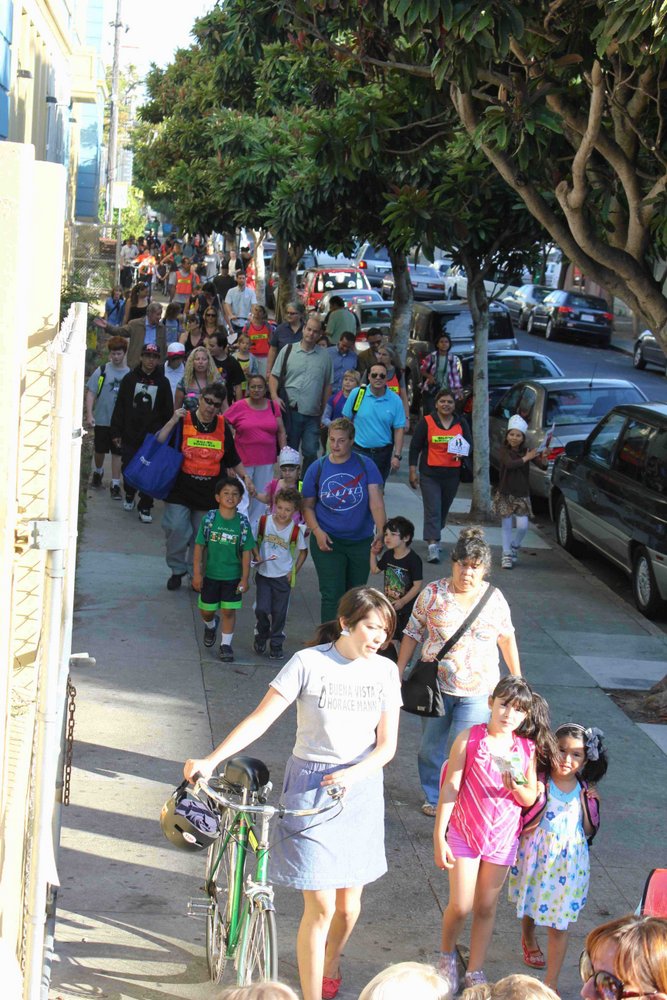
A continuous "walking bus" of school children spanned several sunny blocks of the Mission this morning as the kids made their way to Buena Vista Horace Mann School.
"Drivers just waited and smiled, and everybody had a great morning," said Elizabeth Stampe, executive director of Walk San Francisco.
San Francisco broke records for Walk to School Day today, with an estimated 55 schools and 8,500 students taking part, many of them in walking buses, which provide kids a safe and healthy commute option. In fact, BVHM Principal Jennifer Steiner announced that the school would begin scheduling a weekly walking bus heading out from Parque Niños Unidos, where parents can drop their kids off five blocks away.
Walking in groups provides a presence on the street that not only makes students and parents more visible to drivers, but also sends the signal to slow down perhaps more effectively than any speed limit sign.
Advocates and city officials celebrated the SF Municipal Transportation Agency's implementation of 181 15 MPH school zones. The project, which had just gotten underway by last year's Walk to School Day, was the first of its scale in the state.
But while the city has set a strong example for others to follow, "We're also looking for ways to tame speeds in San Francisco," said Stampe. The danger of streets with high-speed car traffic is one of the main barriers discouraging parents from letting their kids walk to school, she said. "When kids have to cross a street with fast traffic, or cross where cars don't yield like on Monterey Boulevard, that's a real issue for parents."
According to the Department of Public Health, 42 percent of students citywide live within a mile of their school, but only 25 percent walk, said Stampe. Those numbers do vary -- for Buena Vista Horace Mann, located in the walkable Mission District, 23 percent of the students live within a mile, and 19 percent walk.

In a statement, Mikail Ali, commander of the SF Police Department's Traffic Company, said officers are out enforcing the 15 MPH school zones. "Especially now that school’s back in session, we want to remind everyone to please drive slowly and carefully," he said.
But police staff is limited, and enforcement alone won't be enough to calm car traffic, noted Stampe, who encouraged parents to call on the city to redesign safer streets. Traffic calming measures like sidewalk bulb-outs, raised crosswalks, chicanes, narrowed roads and greenery are key to getting drivers to slow down.
"That is probably the best thing to do, is to redesign the streets so that cars simply physically cannot go fast around a school, or in a home zone where it's a residential street," said Cheryl Brinkman, a member of the SFMTA Board of Directors, who spoke at this morning's press event.
When the SFMTA determined which schools were eligible for 15 MPH zones, not all made the cut -- under a 2008 state law, the agency said, 15 MPH speed limits cannot be imposed on streets with more than two lanes. That means some of the widest, most dangerous streets would have to be physically redesigned before speed limits can be lowered.
"A lot of the streets around Bessie Carmichael [Elementary in SoMa] for example, and Broadway in Chinatown, they're right next to schools, and the traffic is really fast, and really scary for parents and kids alike," said Stampe. "That's something the city really needs to tackle."
The SFMTA and other agencies to do continually make pedestrian safety upgrades, develop streetscape redesigns, and implement neighborhood-wide safety projects through the SFMTA's overwhelmed traffic calming program. The agency's Minna-Natoma Home Zone Pilot Project, aimed at measuring the impacts of concentrating traffic calming measures in an area around Marshall Elementary in the Mission, was approved in 2011, but has been only partially implemented.
Street improvement projects typically take years to plan, fund, and construct under the current system, however, and increasing enforcement will be crucial to improving safety in the meantime, said Brinkman, who is a proponent of automated speed cameras. Redesigning streets is "expensive -- we spent 60 or 70 years making our streets the way they are, and now we have to spend all the money to make them safe again," she said. "Enforcement has to be a big part of the solution. We just have to remind drivers: These are streets where there are people, there are children, there are cyclists, and they just need to kind of snap back to attention and realize that."
"We don't just want [kids] and their parents to feel comfortable walking to school," added Brinkman. "We want them to be able to walk to their friend's house, the playground, and to the grocery store with their parents."





